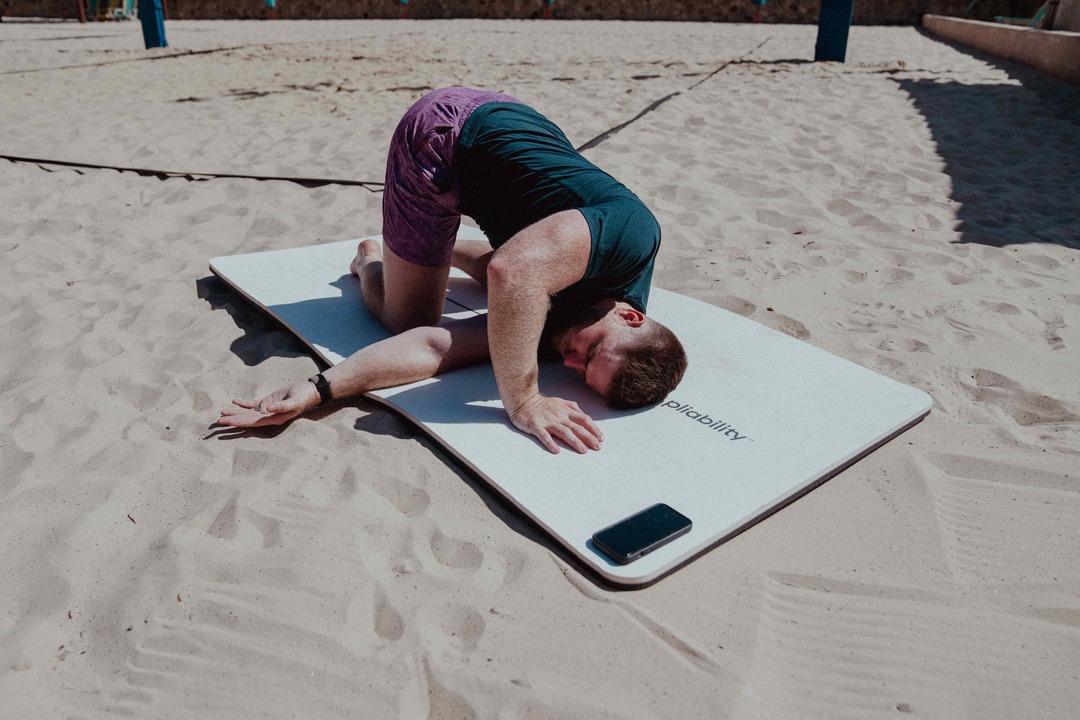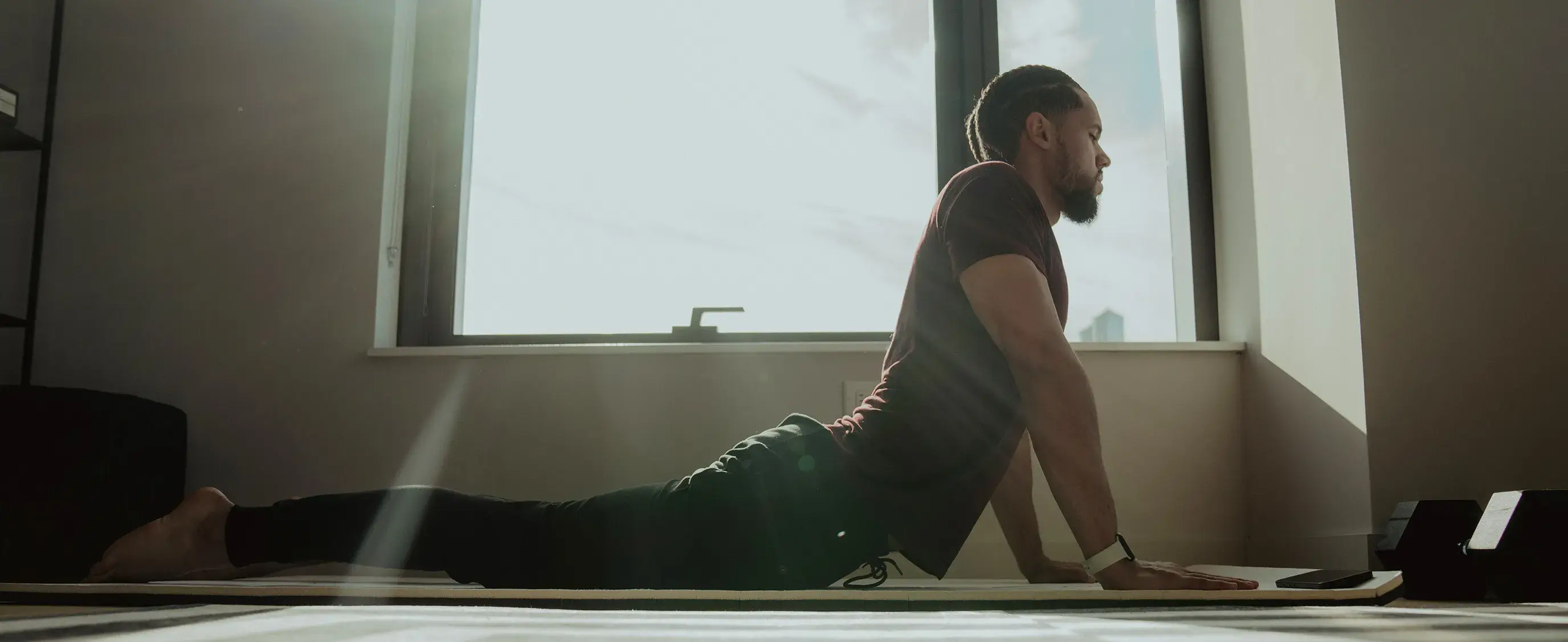We’ve all been there: You crush a workout, feeling pumped about your progress. But then, the following day hits. You wake up sore and tight. Moving feels stiff and painful, and tackling your plans or next workout feels daunting. The truth is, aching muscles can dampen any athlete’s routine. Learning to get rid of sore muscles overnight can help you bounce back faster so you can wake up refreshed, pain-free, and ready to move quickly, without soreness holding you back from your next workout or daily activities. Using the best recovery tools for athletes, such as massage guns, foam rollers, and compression therapy, can also speed up muscle repair and enhance recovery.
Pliability's mobility app offers a valuable tool to help you achieve this goal. With guided routines to relieve muscle soreness and improve recovery, the app enables you to wake up feeling like yourself again to tackle your day without restrictions.
Why Do Our Muscles Get Sore in the First Place?

Sore muscles often wear the badge of honor, signaling a recent workout that challenged the body. I struggle to move for a few days, and that accolade gets old fast.
Delayed Onset Muscle Soreness (DOMS) Explained
"The significant muscle soreness that typically occurs 24 to 48 hours after activity is referred to as delayed onset muscle soreness, or DOMS," says Christopher Hogrefe, M.D., sports medicine and emergency medicine specialist at Northwestern Memorial Hospital.
"This condition appears to be the result of small tears in muscle fiber that combine with an inflammatory process to result in pain." During strenuous activities, especially those involving eccentric contractions (lengthening of muscles under load), tiny micro-tears occur in the muscle fibers.
How Your Body Adapts
These micro-tears are a natural part of the muscle repair and growth process that happens whenever you move in a way you're not used to, when you lift heavier than usual or even walk more than expected. As the body detects these micro-tears, it initiates an inflammatory response to repair the damaged tissues.
The inflammatory process accumulates fluid and metabolic waste products in the affected muscles, contributing to soreness and stiffness. Additionally, the body tries to adapt to its demands by creating stronger muscles to handle similar future challenges better.
Sore Muscles Aren't a Bad Thing
It is crucial to recognize that, though uncomfortable, muscle soreness is not necessarily bad. It indicates that the muscles are adapting and becoming more assertive.
Balancing Exercise Intensity and Recovery for Muscle Growth
Balancing challenging the muscles for growth and allowing adequate rest and recovery to prevent overtraining or injury is essential. Gradually increasing the intensity of exercise and incorporating regular rest days into workout routines can help minimize the extent of muscle soreness and promote overall fitness and well-being.
According to the American College of Sports Medicine, pain should peak around 24 to 48 hours after activity, but it can linger for 3 to 5 days. The length of time muscle recovery takes will depend on several factors, including how conditioned you are, how hydrated you are, how hard you trained, and how much you prioritize recovery.
Related Reading
- What Is Active Recovery
- Why Is Recovery Important for Athletes
- Is Yoga Active Recovery
- Should You Be Sore After Every Workout
- Calves Sore After Running
- Which Muscles Recover the Fastest
- Why Are Ice Baths Good for Muscle Recovery
- What to Do on Recovery Days
- Why Is It Important to Include Recovery Time in a Workout Program?
- What to Drink for Muscle Recovery
How to Get Rid of Sore Muscles Overnight for Pain-Free Mornings

1. Cool Down to Avoid Sore Muscles
A proper cooldown helps muscles recover after exercise. If you’re feeling sore after a workout, focus on returning your body to its pre-exercise state.
Boosting Blood Flow for Faster Muscle Repair
A 2018 study on active recovery found that runners who spent time at a 50 percent decrease in activity at the end of their workout instead of resting completely could go three times longer the second time they ran. The researchers believe it had to do with better blood flow, which reduced blood lactate (the metabolic byproduct that makes your muscles sore).
“So many products that are sold touting the ability to flush from the blood or remove waste products from the muscles, but the way you actually do that is through circulation, or your blood moving,” says Christie Aschwanden, author of GOOD TO GO: What the Athlete in All of Us Can Learn from the Strange Science of Recovery and co-host of the Emerging Form podcast.
2. Drink Tart Cherry Juice
Tart cherry juice is loaded with antioxidants and anti-inflammatory compounds. A 2020 study found that long-distance runners who drank tart cherry juice for eight days reported decreased muscle pain.
"The anti-inflammatory properties in cherries may be beneficial in decreasing muscle soreness. However, particularly in the case of tart cherry extract, one should be aware of the significant sugar content that could be present," says Hogrefe.
3. Get a Massage
It may seem obvious, but massages can help remove sore muscles. There's a little research—a 2012 study found that a post-exercise massage significantly reduces pain by reducing the release of cytokines, compounds that cause inflammation in the body.
At the same time, massage stimulates mitochondria in cells, promoting cell function and repair. Yet, there is not a massive volume of additional research.
A Popular Yet Debated Recovery Method
“If there’s one recovery technique that is most popular among athletes, it’s massage," Aschwanden says. "The scientific evidence for whether it works or is doing something meaningful from a physiological perspective is pretty slim. But what makes massage really helpful is that it feels good and is a way of setting aside some time to relax and check in with your body and how you’re feeling during a little downtime.”
4. Use a Heating Pad
You may have long heard that an ice bath is the best way to recover from a long run, but experts say to skip cold therapy and opt for something warm and comforting.
Boosting Circulation for Muscle Recovery
"The idea behind heating pads is that they increase blood flow because it is a vasodilator (opens up your blood vessels), and is thought that it could help flush some of the byproducts or inflammation related to muscle soreness out of the muscles," says Katie Lawton, an exercise physiologist in Rehabilitation and Sports Therapy at the Cleveland Clinic.
“Heating pads can feel good, which can be helpful for recovery, because oftentimes what you need for recovery is just time to relax,” Aschwanden adds. “Heat also increases circulation, so that can be helpful to reach those areas where you do have waste products [to flush out].”
5. Use a Foam Roller
Foam rolling on sore muscles can make grown men cry, but it seriously helps repair your muscles. “It has been suggested that foam rolling may decrease edema [swelling in the muscles] and enhance tissue healing,” says Hogrefe.
A 2021 study found that 20 minutes of foam rolling on a high-density foam roller immediately following exercise and 24 hours after may reduce muscle tenderness and decrease the impact on one's dynamic movements. Don’t have one? Check out our best foam roller picks.
6. Get More Sleep
It sounds simple, but sore muscles often need to be pounded. The direct scientific link between sleep and post-exercise recovery remains fuzzy. It could be argued that that's because sleep involves many physiological functions that aren't always easy to define and separate clearly.
The Key to Effective Muscle Recovery
We know that a lack of sleep can contribute to higher levels of inflammation. Inflammation may not be a factor in DOMS in particular, but it does contribute to some muscle soreness, and getting profound rest can help alleviate that. “Sleep is the most effective way to improve recovery – a lot of pro athletes are big nappers,” Aschwanden says.
“It’s really important to prioritize sleep because sleep is really when your body does the hard work of recovery. If you’re spending a lot of money on things like a massage gun and tart cherry juice but are only getting six hours of sleep a night, you’re really shooting yourself in the foot.”
7. Eat Antioxidants and Protein Frequently in the Next 24 Hours
Your post-lift protein shake does more than just refuel your muscles. A 2017 study found that protein aided in the recovery of muscle function in the 24 hours following a workout filled with eccentric contractions (which generally happen in most strength-based workouts).
Adding antioxidants to that meal improved recovery from those workouts even more. So aim to load up on protein (think chicken or fish) and antioxidant-rich foods (think pomegranates and kale) in the hours after a challenging workout, and watch your recovery times drop.
8. Keep Moving
We know it sounds counterintuitive, but one of the best ways to alleviate DOMS is to continue to move. Studies have proven it: movement helps bring blood flow and vital nutrients to the muscles to promote recovery.
We're not saying hop back into maxing out your squats, or play in a tackle football game. Simply walking may be enough to give your body what it needs to loosen up some stiffness and pain. As they say, motion is lotion.
9. Hydrate During, Before, and After Your Workout
You've been lectured on getting enough water a million times, but that's because it does so much. Water supports pretty much every bodily function we have. Dehydration may slow down muscle recovery. If you're dehydrated, your heart won't be able to adequately push blood throughout the body, starving your muscles of oxygen and nutrients.
Plus, your muscles won't be able to effectively remove waste products, allowing for more muscle weakness and fatigue. You can prevent this by staying hydrated before, during, and after your workout. Experts recommend getting in between 9 and 13 cups of fluids daily to remain hydrated.
Hydration Strategies for Optimal Workout Recovery
A general suggestion for fluid intake pre- and post-exercise includes:
- 2 to 2.5 cups of water, a couple of hours before exercise
- 1 cup of water during your warm-up, 1 to 1.25 cups of water every 10 to 20 minutes during exercise
- 1 cup of water, no more than 30 minutes after exercise
So, ensure you're drinking enough before and after your workouts. The American Council on Exercise recommends drinking 17 to 20 ounces of water two to three hours before exercise and another eight ounces of water 20 to 30 minutes before the workout.
10. Use Ice or Heat Therapy
You may choose to treat post-workout muscle soreness with temperature-based therapy. Applying ice or using an ice bath to treat inflammation is a standard recovery method when initiated in the first few days after exercise-induced muscle soreness.
Applying heat can be beneficial for relaxing tense, stiff muscles as it increases the flexibility of tissue blood flow. Research shows reduced DOMS symptoms when heat is applied immediately after exercise.
11. Eat Within the Half Hour After an Intense Workout
Post-workout nutrition may help relieve muscle soreness. Add snacks like bananas, berries, spinach, and eggs to help your muscles recover faster, fight inflammation, and lessen next-day soreness.
Experts recommend replenishing with nutrition, especially carbohydrates and protein, shortly after exercise, preferably within 30 minutes, to aid muscle recovery. Optimum protein consumption is crucial to stimulating muscle protein synthesis and facilitating repair.
12. Wear Compression Gear
Compression gear (specialized clothing that fits tightly around the skin) can help heal wounds, inflammation, athletic performance, and recovery. Wearing compression clothing during a workout reduces soreness, thanks to the tight gear's pressure on specific muscle groups.
Compression clothing may also positively impact post-workout recovery.1920 More research is needed on the specifics of compression gear.
13. Try Kinesiology Tape
Kinesiology tape, a special type of stretchy but sturdy tape, supports muscle function and joint stabilization. It may also help decrease muscle pain and swelling. When strategically placed across muscle groups, kinesiology tape slightly lifts the skin and allows space between the fascia and underlying tissues.
This promotes circulation, reduces swelling and inflammation, and facilitates the healing of sore muscles. For DOMS specifically, research suggests that using kinesiology tape for more than 48 hours post-exercise could improve muscle strength and relieve pain.
14. Apply Essential Oils Topically
Some essential oils contain vitamins, antioxidants, and anti-inflammatory properties that help ease joint and muscle pain and swelling. While more evidence is needed, initial research indicates that lavender and rosemary essential oils may be beneficial for relieving muscle pain and stiffness. When massaged topically, lavender may reduce pain and fatigue in people with rheumatoid arthritis.
Rosemary appears to have similar anti-inflammatory effects on pain, swelling, and stiffness. When essential oils are applied to the skin, it's possible to experience an allergic reaction. Before using, you'll want to dilute any essential oil with a carrier oil (like coconut or olive oil).
15. Stick With Light Exercise the Next Day
If you still want to work out but don't feel like going full force, try low-impact exercises or train different areas of the body than those that are sore the next day. Low-impact exercise stimulates blood flow to the muscles and may help reduce some pain without further damaging the muscle fibers and connective tissues.
Related Reading
- Natural Muscle Recovery
- Is Sauna Good for Muscle Recovery
- Is Swimming Good for Recovery
- Benefits of Active Recovery
- How to Speed Up Muscle Recovery
- Should You Workout When Sore
- Active Recovery vs Rest Day
- Active vs Passive Recovery
- How to Speed Up Muscle Strain Recovery
- Muscle Recovery Time by Age
- Recovery Methods for Athletes
Improve Your Flexibility with Our Mobility App Today | Get 7 Days for Free on Any Platform

Pliability offers a fresh take on yoga tailored for performance-oriented individuals and athletes. Our app features a vast library of high-quality videos designed to:
- Improve flexibility
- Aid recovery
- Reduce pain
- Enhance range of motion
Pliability provides daily-updated custom mobility programs for those interested in optimizing their health and fitness. It also includes a unique body-scanning feature to pinpoint mobility issues. If you're feeling limited by pain or the ability to move, Pliability aims to complement your fitness routine and help you move better.
Sign up today for 7 days absolutely for free on iPhone, iPad, Android, or our website to improve flexibility, aid recovery, reduce pain, and enhance range of motion with our mobility app.
Related Reading
- Which Magnesium Is Best for Muscle Recovery
- Hot or Cold Bath for Muscle Recovery
- Benefits of Massage Gun
- Foam Roller Benefits
- Chocolate Milk for Muscle Recovery
- How to Speed Up Muscle Strain Recovery in Back
- Causes of Poor Muscle Recovery
- Active Recovery Workout
- Active Recovery Stretches
- Best Recovery Tools for Runners
- Best Vitamins for Muscle Recovery
- Best Foods for Muscle Recovery
- Workout Recovery Tools







